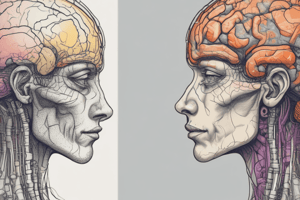Podcast
Questions and Answers
What does the term 'transection' refer to in the context of spinal cord injury?
What does the term 'transection' refer to in the context of spinal cord injury?
- Spinal cord bruising without structural damage
- Compression of the spinal cord without injury
- Partial damage to the spinal cord
- Complete severing of the spinal cord (correct)
Which of the following is a characteristic of neurogenic shock in spinal cord injury patients?
Which of the following is a characteristic of neurogenic shock in spinal cord injury patients?
- Bradycardia and hypotension (correct)
- Increased heart rate and hypertension
- Profound fever and tachycardia
- Hyperthermia and increased respiratory rate
In cases of autonomic dysreflexia, which symptom is most commonly observed?
In cases of autonomic dysreflexia, which symptom is most commonly observed?
- Nausea and luminous vision
- Severe headache and sweating above injury level (correct)
- Hypotension and increased heart rate
- Increased body temperature and tachypnea
Which of the following best describes Cushing’s Triad in the context of traumatic brain injury?
Which of the following best describes Cushing’s Triad in the context of traumatic brain injury?
What Glasgow Coma Scale score indicates the need for mechanical ventilation?
What Glasgow Coma Scale score indicates the need for mechanical ventilation?
What are common manifestations of skull fractures?
What are common manifestations of skull fractures?
What is the implication of a transection injury in the spinal cord?
What is the implication of a transection injury in the spinal cord?
What is a characteristic of neurogenic shock following a traumatic spinal cord injury?
What is a characteristic of neurogenic shock following a traumatic spinal cord injury?
In spinal cord injury management, what is prioritized over other aspects?
In spinal cord injury management, what is prioritized over other aspects?
Which vital sign abnormality is a component of Cushing's triad?
Which vital sign abnormality is a component of Cushing's triad?
What does the Glasgow Coma Scale score of 3 indicate?
What does the Glasgow Coma Scale score of 3 indicate?
What should not be performed in cases of suspected spinal cord injury?
What should not be performed in cases of suspected spinal cord injury?
Which condition can result from inadequate spinal cord injury management?
Which condition can result from inadequate spinal cord injury management?
What is a common cause of spinal cord injuries in adults?
What is a common cause of spinal cord injuries in adults?
What indicates a possible cerebrospinal fluid leak related to a skull fracture?
What indicates a possible cerebrospinal fluid leak related to a skull fracture?
Flashcards
Spinal Cord Transection
Spinal Cord Transection
A complete severing of the spinal cord, often resulting from trauma. This completely disrupts nerve signals below the injury.
Neurogenic Shock
Neurogenic Shock
A life-threatening condition following spinal cord injury, characterized by decreased blood pressure and inadequate blood flow to organs due to a loss of autonomic function.
Cushing's Triad
Cushing's Triad
A set of clinical signs (increased blood pressure, decreased heart rate, irregular respirations) that may indicate increased intracranial pressure in patients with TBI.
Glasgow Coma Scale (GCS)
Glasgow Coma Scale (GCS)
Signup and view all the flashcards
Autonomic Dysreflexia
Autonomic Dysreflexia
Signup and view all the flashcards
Rhinorrhea
Rhinorrhea
Signup and view all the flashcards
Otoorrhea
Otoorrhea
Signup and view all the flashcards
Neurogenic Shock
Neurogenic Shock
Signup and view all the flashcards
Cushing's Triad
Cushing's Triad
Signup and view all the flashcards
Glasgow Coma Scale (GCS)
Glasgow Coma Scale (GCS)
Signup and view all the flashcards
Transection
Transection
Signup and view all the flashcards
Spinal Cord Injury (SCI)
Spinal Cord Injury (SCI)
Signup and view all the flashcards
Tetraplegia
Tetraplegia
Signup and view all the flashcards
Paraplegia
Paraplegia
Signup and view all the flashcards
PERRLA
PERRLA
Signup and view all the flashcards
Study Notes
Spinal Cord Injury and Traumatic Brain Injury
- Clinical Manifestations: Clinical presentations of spinal cord injury vary depending on the injured level (cervical, thoracic, lumbar).
- Transection: Complete disconnection of the spinal cord.
- Neurogenic Shock: A life-threatening condition following spinal cord injury. Characterized by hypotension, bradycardia, and warm, dry skin. Nursing management includes fluid resuscitation and vasoconstrictors.
- Spinal Cord Injury Complications: Complications can impact skin, bowel, bladder, and respiratory function. Bowel and bladder dysfunction, skin breakdown (pressure ulcers), and respiratory issues are priorities in monitoring.
- Autonomic Dysreflexia: A dangerous condition in patients with spinal cord injury. Symptoms: high blood pressure, headache, flushing, and sweating. It's crucial to immediately manage these symptoms.
- Head Injuries in Adults: Common causes include motor vehicle accidents, falls, and direct trauma to the head.
- Traumatic Brain Injury (TBI) Clinical Manifestations: Changes in vital signs (Cushing's triad), pupil response, and Glasgow Coma Scale (GCS) assessment.
- Cushing's Triad: Includes hypertension, bradycardia, and irregular respiratory patterns, a symptom of increased intracranial pressure.
- Pupil Response: Important sign of brain function and to observe for any changes in size and responsiveness.
- Glasgow Coma Scale (GCS): A scoring system used to assess the level of consciousness in patients with TBI. Scoring determines if mechanical ventilation is required and if coma or brain death is present.
- Nurse Assessment: Neuro assessment components for TBI patients include: PERRLA, grip strength (hand squeeze), visual changes, changes in level of consciousness (LOC), and monitoring vital signs.
- Skull Fracture Manifestations: These may include Rhinorrhea (CSF drainage from the nose) and otorrhea (CSF drainage from the ears). Important to note for diagnosis and avoid damaging the brain further with procedures.
Studying That Suits You
Use AI to generate personalized quizzes and flashcards to suit your learning preferences.
Related Documents
Description
This quiz explores clinical manifestations, complications, and management of spinal cord injuries and traumatic brain injuries. Participants will assess knowledge of neurogenic shock, autonomic dysreflexia, and head injuries, which are crucial for nursing practice. Test your understanding of these critical topics in patient care.




